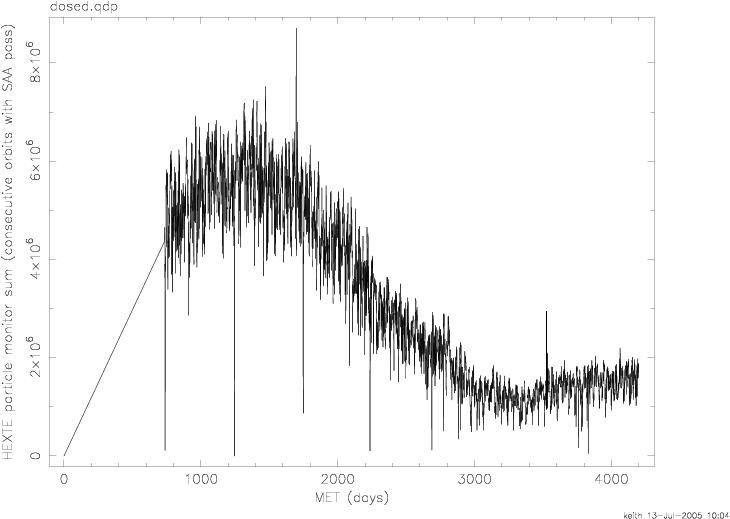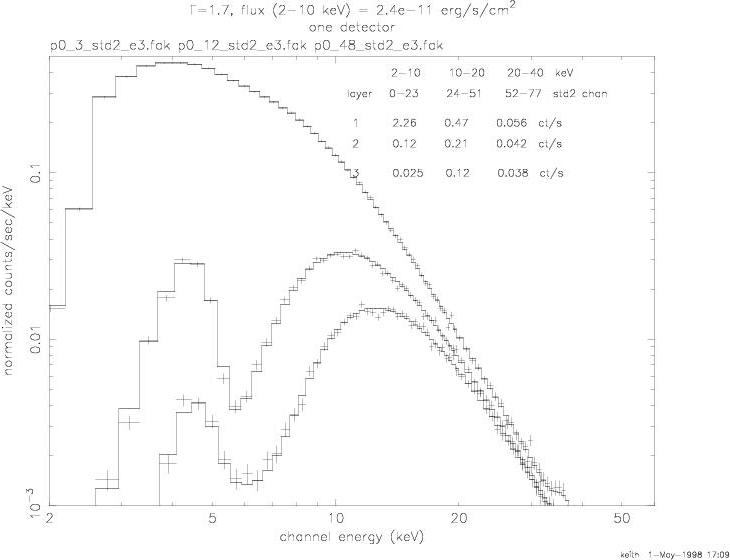|
Proportional Counter Array (PCA)
This page collects links to published and unpublished material relevant to the calibration and
operation of the PCA. The material here was substantially re-organized and improved May 2005.
If you are aware of PCA related calibration
material that should be linked here, please contact
Keith Jahoda
Calibration Summaries"Calibration of the Rossi X-ray Timing Explorer Proportional Counter Array" Jahoda et al. 2006, ApJS, 163, 401.Response matrix, energy scale, background, and absolute timing budget. Also available from ADS and astro-ph "In Orbit Performance and Calibration of the RXTE PCA" Jahoda et al., 1996, Proc SPIE 2808, 59. Includes examples of timing windows Glasser, Odell, and Seufert , 1994, IEEE-Trans Nucl Sci, NS-41(4), 1343. Zhang et al., 1993, Proc SPIE 2006, 324. Historical summaries of calibration related topics. Energy Response MatrixAn extensive summary of response matrix issues can be found in the PCA Calibration paper (see Calibration Summaries section above).June 2011. The PCA team has released a new set of effective area values in HEASoft 6.11. These new values should provide improved agreement between individual PCUs, and an overall change in the PCA effective area of about 0.4%. The report Improvements to the PCA Effective Area (HEASoft 6.11) has more details. August 2009. Significant improvements to the PCA response matrix have been made. Changes to both the energy-to-channel relationship, and the modeling of L-escape lines, improves the performance of the response significantly. Users will need to use PCARMF version 11.7 and PCA CALDB dated 2009-08-17 or later. The report Improvements to the PCA Response Matrix (version 11.7) has more details.
Instructions on how to make response matrices (page under development) Energy Calibration of RXTE/PCA in ftools v5.3 and Beyond, K. Jahoda, poster presented at the X-Ray Timing 2003 workshop, Cambridge MA, November 2003 (unpublished). PCA pile-up and the Impact on the Energy Spectrum of GRO J1655-40, J. A. Tomsick and P. Kaaret, 1998, (unpublished). At high rates, two events can be measured simultaneously and produce a single (summed) pulse height.
Absolute TimingAn discussion of the overall RXTE and PCA timing errors can be found in the PCA Calibration paper (see Calibration Summaries section above)."Microsecond Timing of PSR B1821-24 with Chandra High Resolution Camera-S" R. E. Rutledge et al., 2004, ApJ, 613, 522. Compares absolute timing of Chandra, RXTE, and radio RXTE Observation of the milli-second pulsar PSR 1821-24 Saito, Y. et al., 2001, in "New Century of X-ray Astronomy, ASP Conference Proceeding 251. Short term stability of the RXTE clock "Rossi X-ray Timing Explorer Absolute Timing Results for the Pulsars B1821-24 and B1509-58" A. H. Rots et al., 1998, ApJ, 501, 749. "Study of the Stability of the Time Assignment of the XTE Clock using the Sharp Pulse of PSR 1821-24" Y. Saito 1998. (unpublished) Timing alignment with BATSE . K. Jahoda, S. Barthelmy, F. Marshall, and A. Rots, 1996 (unpublished). The coincidence rate allows a gross (sub-second) timing alignment check with BATSE. Fall 1996 Background Daily Radiation dose. This figure shows the daily integrated HEXTE particle
montior rate over the course of the mission. MET day 0 is ~01 Jan 1994 in this figure. The decline in the
rate is correlated with RXTE altitude
Daily Radiation dose. This figure shows the daily integrated HEXTE particle
montior rate over the course of the mission. MET day 0 is ~01 Jan 1994 in this figure. The decline in the
rate is correlated with RXTE altitudeAn extensive summary of the development of the background model can be found in the PCA Calibration paper (see Calibration Summaries section above). Newest Background Models Can be found on the PCA Digest Page. December 2009. "Spike Artifacts in PCA Background Estimates" C. Markwardt et al. 2007 (unpublished). The PCA team discovered that PCABACKEST version 3.7 and earlier can produce spike-like artifacts in estimated background files. These artifacts can affect spectra and light curves, depending on the energies and techniques used. The PCA team recommends that users immediately download and use pcabackest version 3.8, available from the HEASOFT 6.8 release. Users can find a more detailed description of the issues in the linked report. September 2007. "PCA SAA History and Background Problems" C. Markwardt et al. 2007 (unpublished). Describes two problems with current background estimation methods: (1) The SAA "History" file contains several significant errors; (2) a bug in the pcabackest tool causes incorrect background estimates. The report discusses the nature of the problems, the impacts, and corrective actions that users can take. August 2006. "Revised PCA Background Models of 2006" C. Markwardt 2006 (unpublished). Describes new improved background models for Epoch 5 (covering May 2000-present), which removes slow systematic residual trends. April 2004. "Corrected RXTE PCA Background Models" C. Markwardt 2004 (unpublished). Describes an error in the previously released versions of the background model. These models have since been superceded. February 2002. Markwardt et al. "Practical Advice for Users of New RXTE PCA Background Models", C. Markwardt et al. 2002 (unpublished). Construction and systematics of improved background models. These models have since been superceded. Instructions on how to make models (2002 and beyond) with tools further developed by C. Markwardt (GSFC only, or by request) Instructions on how to make models (~2000) with the tools developed by M. Stark and D. Smith GSFC only, or by request David Smith's background systematics page (2000) July 2000 status report Separation of blank sky data into "model" and "test" segments shows that model works well for completely independent test data. Probable authors D. Smith and K. Jahoda (unpublished) "Evidence of Activation". M. Stark 1996 (unpublished). Evidence for an activation component in the PCA background DeadtimeX-ray Power Density Specta of Black Hole Binaries: a new Deadtime Model for the RXTE PCA, Dennis Wei, 2006. Senior Thesis submitted to the MIT Dept. of PhysicsPeak Luminosities of Bursts from GRO J1744-28 measured with the RXTE PCA K. Jahoda et al., 1999, Nuclear Physics B Proceedings Supplements, 69, 210. Use of the coincidence rates to improve estimates of the incident flux when deadtime is large. Faint Source deadtime W. Zhang and K. Jahoda 1998 (unpublished). Who Should Correct for PCA deadtime? M. Stark and K. Jahoda 1998 (unpublished) Timing Signatures and other non-source related variability"Deadtime Modifications to FFT Power Spectra", W. Zhang et al., 1995, ApJ, 449, 930. Pedagogical study of the effects of deadtime on power spectra.Timing signatures. E. H. Morgan and K. Jahoda 1996 (unpublished). High frequency instrumental timing signatures. NGC 1068 K. Jahoda 2000 (unpublished). Investigation of probable non-source related emission during observation of NGC 1068 2004 - deserves reassessment Examples of non cosmic bursts in the PCA data. K. Jahoda and T. Strohmayer (unpublished) Other examples will be catalogued here as I find or am made aware of them
Xue and Cui , " X-ray Flares from Markarian 501", astro-ph preprint (12/2004, ApJ in press) discusses flares associated with "electron" rate. Field of ViewAn extensive summary of the PCA field of view can be found in the PCA Calibration paper (see Calibration Summaries section above)."Field of View of the PCA", T. Strohmayer and K. Jahoda, 1998 (unpublished, partly in 2005 Calibration paper). Flux ScaleFlux scale of the PCA. K. Jahoda 2005 (unpublished, partly in 2005 calibration paper and a Jahoda et al. study of the Cosmic X-ray Background flux determined from the HEAO-1 A2 experiment, in preparation). The PCA flux scale in Ftools 5.3 and 6.0 is normalized so that a deadtime corrected spectrum of the Crab gives the same 2-10 keV flux as reported in Zombeck's handbook, which turns out to be one of the highest reported values.Crab spectra (1998) MiscellaneousThe PCA loss of pressure in spring 2000.Pressure history in PCU 1 during May 1999 (unpublished) Burst Expectation Search Code, described in "An Efficient Algorithm for the Detection of Infrequent Rapid Bursts in Time Series Data" A. B. Giles (1997) ApJ, 474, 464. DocumentsThis document is maintained by Keith JahodaIf you have a question about RXTE, please send email to one of our help desks.
|


